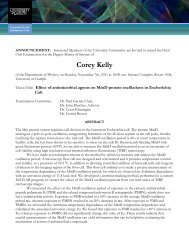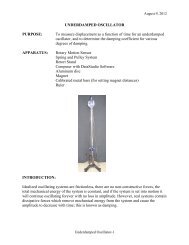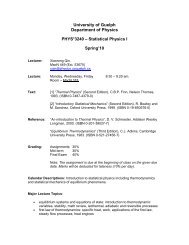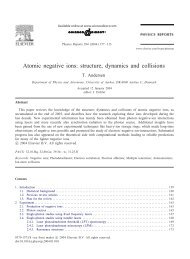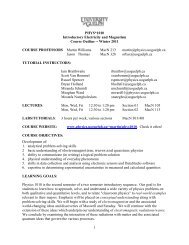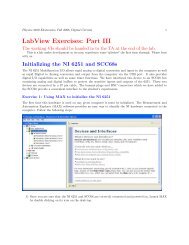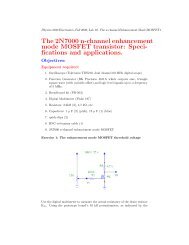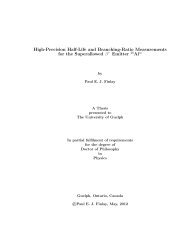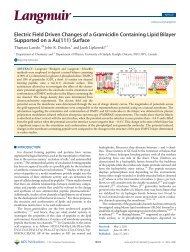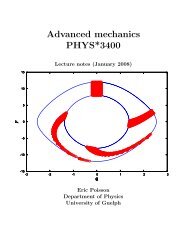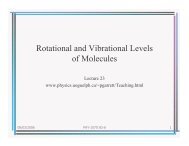Geant4 Simulations for the Radon Electric Dipole Moment Search at
Geant4 Simulations for the Radon Electric Dipole Moment Search at
Geant4 Simulations for the Radon Electric Dipole Moment Search at
You also want an ePaper? Increase the reach of your titles
YUMPU automatically turns print PDFs into web optimized ePapers that Google loves.
lower its total energy. Internal conversion occurs when <strong>the</strong> excited nucleus interacts<br />
with an electron in one of <strong>the</strong> lower <strong>at</strong>omic orbitals (K, L, etc), causing <strong>the</strong> electron<br />
to be ejected from <strong>the</strong> <strong>at</strong>om. This process becomes domin<strong>at</strong>e <strong>for</strong> higher Z nuclei and<br />
is more probable <strong>for</strong> transitions of lower energy. The γ decay and internal conversion<br />
processes are competitive. For any excited st<strong>at</strong>e <strong>the</strong> probabilities <strong>for</strong> ei<strong>the</strong>r process<br />
are given by<br />
P γ = 1<br />
1+α , P IC = α<br />
1+α , (3.1)<br />
where α is <strong>the</strong> total internal conversion coefficient.<br />
Internal conversion coefficients used in <strong>the</strong> RnEDM simul<strong>at</strong>ions were calcul<strong>at</strong>ed<br />
with <strong>the</strong> BrIcc v2.2b program [44]. The BrIcc program calcul<strong>at</strong>es <strong>the</strong>oretical internal<br />
conversion coefficients based on a rel<strong>at</strong>ivistic self-consistent Dirac-Fock model [44].<br />
Given <strong>the</strong> proton number and energy of <strong>the</strong> transition, <strong>the</strong> program outputs <strong>the</strong> total<br />
and individual shell conversion coefficients <strong>for</strong> multipolarities up to L = 5. For mixed<br />
transitions involving multipolarities L1 and L2, such as an M1+E2 transition, <strong>the</strong><br />
conversion coefficient can be calcul<strong>at</strong>ed by [44]<br />
α = δ2 α L2 +α L1<br />
(1+δ 2 )<br />
(3.2)<br />
where δ, <strong>the</strong> mixing r<strong>at</strong>io, is defined as<br />
δ = 〈J f||L 2 ||J i 〉<br />
〈J f ||L 1 ||J i 〉 . (3.3)<br />
The total internal conversion coefficient is defined as a sum of all <strong>the</strong> individual shell<br />
internal conversion coefficients, such th<strong>at</strong> α Tot = α K + α L + α M + ···. Thus, <strong>the</strong><br />
probabilities <strong>for</strong> an electron to be emitted from a particular shell is easily calcul<strong>at</strong>ed<br />
from <strong>the</strong> BrIcc output. For example, <strong>the</strong> probability <strong>for</strong> an electron to be emitted<br />
from <strong>the</strong> K shell is simply α K /α Tot . Simul<strong>at</strong>ing <strong>the</strong> <strong>at</strong>omic shell structure enabled<br />
41



